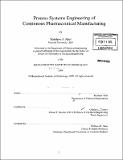| dc.contributor.advisor | Charles L. Cooney. | en_US |
| dc.contributor.author | Abel, Matthew J | en_US |
| dc.contributor.other | Massachusetts Institute of Technology. Dept. of Chemical Engineering. | en_US |
| dc.date.accessioned | 2010-09-03T18:53:23Z | |
| dc.date.available | 2010-09-03T18:53:23Z | |
| dc.date.copyright | 2009 | en_US |
| dc.date.issued | 2010 | en_US |
| dc.identifier.uri | http://hdl.handle.net/1721.1/58446 | |
| dc.description | Thesis (Ph. D.)--Massachusetts Institute of Technology, Dept. of Chemical Engineering, February 2010. | en_US |
| dc.description | Cataloged from PDF version of thesis. | en_US |
| dc.description | Includes bibliographical references (p. 290-299). | en_US |
| dc.description.abstract | Continuous manufacturing offers a number of operational and financial benefits to pharmaceutical companies. This research examines the critical blending step for continuous pharmaceutical manufacturing and the characteristics of continuous downstream pharmaceutical manufacturing systems. Discrete element method (DEM) simulations were used to develop novel insights into the mechanism of mixing for continuous blending of cohesive pharmaceutical powders and to examine the effects of particle properties, blender design and operating conditions on blend homogeneity. To place continuous blending into the context of pharmaceutical manufacturing, the scope of the analysis was expanded to process system models of continuous downstream pharmaceutical manufacturing. DEM simulations were used to study the mechanisms of mixing in the continuous blending of pharmaceutical powders. Diffusive mixing from the avalanching particles appears to be the dominant mechanism of mixing in both the axial and radial direction for the double helical ribbon blender. This result can guide the development of future continuous pharmaceutical powder blenders by optimizing the mixing elements to increase the amount of particles transported to a position where they can avalanche/flow and diffusively mix. A range of particle properties, blender designs and operating conditions were examined for their effects on flow behavior and blend homogeneity. Three particle properties were examined: particle size, polydispersity and cohesive force. | en_US |
| dc.description.abstract | (cont.) Particle size was observed to be positively correlated to both flow rates and blend homogeneity. Polydispersity had no effect on flow rate and was negatively correlated to homogeneity. Cohesive force was negatively correlated to flow rate and had little to no effect on homogeneity. Two modifications of blender design were analyzed: changes in blender size and changes in shaft design. Blender size was observed to be positively correlated to flow rate and negatively correlated to homogeneity. The paddle shaft designs created a more homogeneous powder blend than the double helical ribbon shaft. Two operating parameters were also studied: rotation rate and fill fraction. Rotation rate was positively correlated to both flow rate and homogeneity. Fill fraction had the interesting result of being positively correlated to the absolute flow rate, but negatively correlated to the fill mass normalized flow rate. In addition, fill fraction has a clear negative correlation to homogeneity above fill fractions of 0.55, but is inconsistent for fill fractions lower than this. This research on particle properties, blender designs and operating conditions will help to guide the operation of continuous pharmaceutical blenders and the design of continuous pharmaceutical manufacturing systems. Process simulations comparing model batch and continuous downstream pharmaceutical manufacturing systems have quantified some of the potential size, cost and performance benefits of continuous processes. The models showed significant reductions in process equipment sizes for continuous manufacturing particularly in the blending step. | en_US |
| dc.description.abstract | (cont.) This reduction in equipment size translates to capital cost (CAPEX) savings for both the continuous process equipment and manufacturing facilities. The steady state operation of continuous processing also reduces the labor requirements and gives the continuous processes an operating cost (OPEX) advantage over batch processes. This research has contributed to the understanding of continuous pharmaceutical powder blending and quantified some of the benefits of continuous downstream pharmaceutical manufacturing. This work is being continued by the Novartis-MIT Center for Continuous Manufacturing whose work is providing the foundation for future industrial scale pharmaceutical continuous manufacturing systems. | en_US |
| dc.description.statementofresponsibility | by Matthew J. Abel. | en_US |
| dc.format.extent | 299 p. | en_US |
| dc.language.iso | eng | en_US |
| dc.publisher | Massachusetts Institute of Technology | en_US |
| dc.rights | M.I.T. theses are protected by
copyright. They may be viewed from this source for any purpose, but
reproduction or distribution in any format is prohibited without written
permission. See provided URL for inquiries about permission. | en_US |
| dc.rights.uri | http://dspace.mit.edu/handle/1721.1/7582 | en_US |
| dc.subject | Chemical Engineering. | en_US |
| dc.title | Process systems engineering of continuous pharmaceutical manufacturing | en_US |
| dc.type | Thesis | en_US |
| dc.description.degree | Ph.D. | en_US |
| dc.contributor.department | Massachusetts Institute of Technology. Department of Chemical Engineering | |
| dc.identifier.oclc | 615607273 | en_US |
